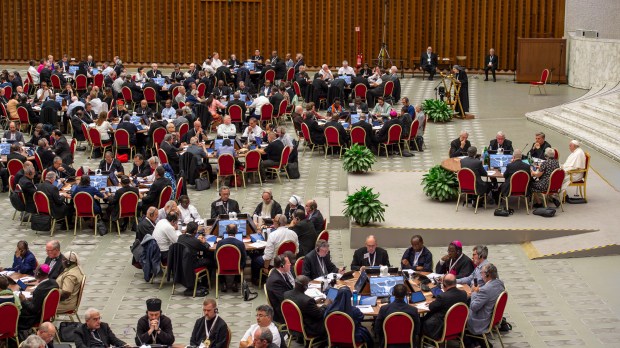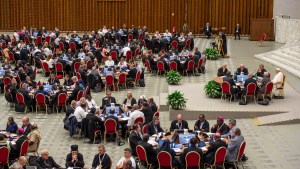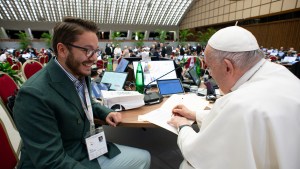In the evening of October 28, 2023, in Rome, the members of the Synod on Synodality voted to approve the synthesis report. This document was the fruit of intense discussions that took place in the final days of the October session.
The first version presented to assembly members on October 25 was the subject of 1,251 amendments.
I.Media has obtained a draft of the summary report, and here we take a look at the most significant changes.
The nature of the document
This report is decisive for the continuation of the Synod on Synodality. It is intended to serve as a guide from now until the final session, which will take place in Rome in October 2024.
Between now and then, dioceses around the world will be asked to process the report and send their impressions back to Rome. This will fulfill the Synod organizers’ wish to continue the back-and-forth between the local and the universal levels initiated in 2021, in order to take into account the aspirations of the whole “people of God.”
Some 40 pages long, the report was prepared during the Synod by experts under the guidance of two special secretaries. A commission of 13 Synod members was responsible for overseeing its production.
The draft of this text, which was intended to condense the reflections raised during the month’s work, was presented to all members of the assembly on October 25. A total of 1,251 amendments were raised: 1,125 collective requests from language groups and 126 individual requests. According to our information, collective requests were naturally taken more into account, as certain individual requests are not reflected in the definitive text.
The final version of the report contains significant changes. From workarounds to reformulations, the changes express the tensions inherent in the work. This is notable especially regarding questions of sexuality, the ministries of the laity — of women in particular — and the concept of shared responsibility.
Disagreement on sexual issues
One of the most notable differences between the two texts is the disappearance of the references to “divorced people in second unions” and “people who identify as LGBTQ+.” These words have been replaced by a more general proposal referring to “people who feel marginalized or excluded […] because of their marital status, identity or/and sexuality.”
The removal of the term LGBTQ+ is significant. In addition to being present in the draft, it was already part of the Synod’s Instrumentum laboris, the public document that guided the work of Synod members.
Issues relating to the accompaniment of those who experience same-sex attraction are very sensitive in the Church. German Catholics, for example, officially expressed their wish to review Church teaching on this subject and authorize priests to bless homosexual couples. This stance is not shared by some other regions of the world, such as Africa or the Middle East.
The disappearance of the term “LGBTQ+” and any mention of “homosexuality” testifies to the attitude of a significant number of the assembly’s members. During the Synod, “Africa made its voice heard, but not only Africa; also Europe and the United States,” says one bishop. “The voices of some Africans were heard, but we have to qualify that. Even in the West, the question of the pastoral care of homosexuals is the subject of debate, and the episcopates are divided,” agrees an observer.
Persons vs. lobbies, and encouraging the faithful
He also points out that the Pope has given a key for interpretation, distinguishing between homosexual “persons,” who are “children of God,” and the “groups” that defend homosexuals. “Lobbies are a different matter,” said the Pope during his trip to South Sudan in February.
“For some, the term ‘LGBTQ+’ may evoke these pressure groups. No doubt some members in the room felt this pressure,” adds the observer.
Another element demonstrates the assembly’s determination not to revise the Church’s current teaching on certain sensitive issues. The members added a paragraph dedicated to people who live alone, having made the choice of “fidelity to the Church’s Tradition and Magisterium on marriage and sexual ethics.” This mention, which was not present in the first version, is a way of encouraging, in particular, divorced people who choose not to enter into a new union, or those with same-sex attraction who live in continence.
On the other hand, regarding “controversial doctrinal, pastoral, and ethical issues,” the final document has added the possibility of listening to “people directly affected by the matters under consideration” to address them. Contrary to previous attenuations, we can see here the will to open the door to better listen to people living in situations deemed irregular by the Church.
The voices of women, resolutely more active
In terms of new features, the final version is more incisive on the need to consider the role of women. The text has been extensively reworked. As a result, women appear more as protagonists and included than in the first version, which referred to their “needs,” a word that has been removed.
In the new text, it is the assembly — and not just the women on their own — that calls for “a Church in which men and women dialogue together” so as to be “together as protagonists, without subordination, exclusion, and competition.”
The proposals regarding women are a little more ambitious than in the first version. They call for women to assume “roles of responsibility,” without conditioning these with a cautious “where possible.”
Again in terms of novelties, it denounces the condition of consecrated women “too often considered as cheap labor.” There is also a call for women judges in all canonical trials, and for “the feminine contribution” to be valued in the training of priests.
Ministries for women
In a very concrete addition, the Synod asks to see on time for the 2024 assembly the results of a study on women’s access to the diaconate, which the Pope commissioned but the results of which have remained secret.
On the other hand, a visibly contentious paragraph has disappeared, mentioning “different points of view on how […] sexual difference should shape ecclesiology and the approach to ministries.” The opening to “new ministries” for women has been turned into a conditional, in a more cautious formula than the first version.
In addition, the “inclusive language” desired in liturgical texts and Church documents has been corrected to become “language that takes into equal consideration both men and women.”
The paragraphs on the place and role of women in the Church were the most debated. Nearly 20% of members (69 out of 277), for example, opposed the article mentioning “different positions […] regarding women’s access to the diaconal ministry.”
“During the Synod, men took the floor, cardinals for example, to talk about the value of women in the Church,” says one observer. “The place of women seems to me to have been the theme that generated the most exchanges during the discussions in preparation for the document,” confirms a bishop who took part in the discussions.
The future of synodality
The official document states that synodality represents “the future of the Church.” But an earlier version contained the assertion that “any step backwards seems impossible.” This is a sort of rhetoric used by certain German bishops — themselves engaged for three years in a national Synod with the appearance of a great reform — which could have caused grinding of teeth in the opposite wing. The expression was therefore dropped.
The draft also envisaged the creation of a theological study commission to refine the understanding of synodality — a suggestion which was also deleted. Seemingly aiming to spare sensitivities, the text refers to work already carried out by the theological commission.
On the other hand, the idea of a commission to study the “canonical implications” of synodality was conserved. On this technical subject, an entire paragraph has been introduced, stating that “the time seems to have arrived for a revision of the Code of Canon Law,” and calling for “a preliminary study.”
According to our information, a cardinal member of the C9 made a noteworthy intervention during the closed-door debates, affirming that the Code of Canon Law could be modified and was not a criterion for discernment on its own.
No permanent synod
Another noteworthy deletion was the possibility of “a permanent synod of bishops elected by the episcopal conferences in support of the Petrine ministry.” This formulation has disappeared, to be replaced by the request to “enhance and strengthen the experience of the C9 as a synodal council at the service of the Petrine ministry.”
This council of cardinals (less than a dozen) is a creation of Pope Francis. From the start of his pontificate in 2013, he wanted to surround himself with cardinals from the four corners of the world to assist him in his government and reform of the Roman Curia.
For one observer, three factors may have prompted the members of the assembly to withdraw the plan for a permanent Synod around the pope. Firstly, the fear of “bureaucratizing” and “weighing down” the Church’s consultation and decision-making processes even further, when structures already exist. Secondly, the fear of creating a kind of “elite” among Catholics. Such people would be experts in synodality who would end up no longer being representative of the people of God. Finally, the desire not to institutionalize a “perpetual questioning movement” within the Church.
The relationship between the roles of laity and clerics
The sharing of responsibilities between laity and clergy remains controversial, and has been nuanced by the amendments. For example, on the delicate question of “ministries,” certain usages of the word have been changed to improve its etymology for one that is undoubtedly more meaningful: “service.”
A new paragraph asks for “any ambiguities” to be clarified regarding the term “an all-ministerial Church” used in the Instrumentum laboris for this Synod.
In the same vein, we note that clarifications have been made regarding the participation of lay people. The first version spoke simply of the mission conferred by “baptism,” whereas the final version prefers to speak of “sacraments of Christian initiation” (baptism, communion, confirmation).
In other words, when it comes to making decisions, the bishops want to surround themselves with lay people who live their faith in practice, as one participant explained to I.Media. The idea is to entrust discernment to people who are trained and prepared.
In the first text, the assembly expressed concern about the lack of participation of priests — who were poorly represented among the participants — in the Synod. This concern is extended in the final document to deacons and bishops, with a clear call to “understand better the reasons why some have felt resistant to the synodal process.”
New ministries
The synthesis report calls for “more creativity in establishing ministries according to the needs of local churches.” It suggests broadening the charges of the ministry of lector (which Pope Francis opened up to women in January 2021), which could become “a fuller ministry of the Word of God” that could include “preaching.”
In addition, the synod fathers and mothers envisage a new ministry with which married couples could be vested. This ministry would “support family life” and “accompany people preparing for the sacrament of marriage.” These perspectives were already present in the first draft.
Abuse and clericalism, the focus of the assembly
The abuse crisis was also the subject of amendments. Right from the introduction, in paragraph 1/a, the editors added a sentence stating, “The long journey towards reconciliation and justice, including addressing the structural conditions that abetted such abuse, remains before us, and requires concrete gestures of penitence.”
The section on deacons and priests is more developed, with new proposals to promote “transparency and a culture of accountability” in the Church. There is also an addition on clericalism “which can manifest itself not only among ministers but also among the laity.”
Other new initiatives: In the section on bishops, a request is made to verify the criteria for selecting candidates for the episcopate, “balancing the authority of the Apostolic Nuncio with participation of Episcopal Conferences.” And the assembly slipped in the project of “pastoral services” to be assigned to priests who have left ministry. This paragraph was one of the least unanimously approved.
On the ecumenical front, the document has been toned down. A first version, which was deleted, spoke of “resistance to dialogue, encounter, and common work” between Christian confessions. And the idea of a specific liturgy for mixed marriages has been dropped.
More voices from the South
On reading the final version, it seems that many of the amendments have been made in favor of the voices of the South. A number of elements support this impression.
In the section on the poor as protagonists in the Church, which is much more detailed than the first version, several categories of marginalized people have been introduced. In addition to indigenous people, the text speaks of “Afro-descendant peoples” and victims of racism. This latter word and its derivatives, which appeared only once in the draft, appears five times in the final report. An entire paragraph has been added on the fight against “systems within the Church that create or maintain racial injustice.”
In what also seems to echo the voices of countries in the South, the editors point out that “in some places, the proclamation of the Gospel was associated with colonization, even genocide,” the latter term being added.
The mention by name of countries at war — Ukraine, the Holy Land and the Middle East — has been removed, leaving only the generic term “many countries on several continents.” This suggests a protest from African countries in particular, which are prey to many forgotten conflicts.
Finally, while the term LGBTQ+ was removed from the initial draft, the addition of a paragraph on a specifically African theme in the final synthesis shows how this continent was able to make its voice heard when it came to amending the text. In the final report, the Episcopal Conferences of Africa and Madagascar (SECAM) are asked to “promote a theological and pastoral discernment on the question of polygamy and the accompaniment of people in polygamous unions who are coming to faith.”



